Origin of Mélanges of the Franciscan Complex, Diablo Range and Northern California: An Analysis and Review
Abstract
1. Introduction
2. Distinguishing Sedimentary, Diapiric, and Tectonic Mélanges
3. Data from Selected Franciscan Mélanges
3.1. Sedimentary Mélanges
3.1.1. The Crescent City Olistostrome
3.1.2. The Laytonville Mélange
3.1.3. The King Ridge Road Mélange
3.1.4. Hillside Mélange
3.1.5. Other Sedimentary Mélanges
3.2. Tectonic Mélanges
3.2.1. Rodeo Cove Mélange
3.2.2. The Ingram Canyon Mélange
3.2.3. The Jenner Headlands Mélange
3.2.4. Other Tectonic Mélanges
3.3. Diapiric Mélanges
3.4. Mélanges of Polygenetic and Debated Origin
3.4.1. The Heavens Beach Mélange
3.4.2. The Ring Mountain Mélange
3.4.3. Other Mélanges
4. Discussion and Conclusions
Funding
Acknowledgments
Conflicts of Interest
References
- Ernst, W.G. Accretion of the Franciscan Complex attending Jurassic-Cretaceous geotectonic development of northern and central California. Geol. Soc. Am. Bull. 2011, 123, 1667–1678. [Google Scholar] [CrossRef]
- Raymond, L.A. What is Franciscan?: Revisited. Int. Geol. Rev. 2017, 60, 1968–2030. [Google Scholar] [CrossRef]
- Wakabayashi, J. Anatomy of a subduction complex: Architecture of the Franciscan Complex, California, at multiple length and time scales. Int. Geol. Rev. 2015, 57, 669–746. [Google Scholar] [CrossRef]
- Aalto, K.R. Multistage mélange formation in the Franciscan Complex, northernmost California. Geology 1981, 9, 602–607. [Google Scholar] [CrossRef]
- Berkland, J.O.; Raymond, L.A.; Kramer, J.C.; Moores, E.M.; O’Day, M. What is Franciscan? Am. Assoc. Pet. Geol. Bull. 1972, 56, 2295–2302. [Google Scholar]
- Aalto, K.R. Examples of Franciscan Complex mélanges in the northernmost California Coast Ranges, a retrospective. Int. Geol. Rev. 2014, 56, 555–570. [Google Scholar] [CrossRef]
- Bero, D.A. Geology map of the western portion of the Jenner Headlands. In Jenner Headlands Integrated Management Plan; Edwards, B.R., Chestnut, A., Eds.; Sonoma Land Trust: Santa Rosa, CA, USA, 2012; The Wildlands Conservancy: Oak Glen, CA, USA, 2010. [Google Scholar]
- Cloos, M. Flow mélanges: Numerical modeling and geologic constraints on their origin in the Franciscan subduction complex, California. Geol. Soc. Am. Bull. 1982, 93, 330–345. [Google Scholar] [CrossRef]
- Cloos, M.; Shreve, R.L. Subduction channel model of prism accretion, mélange formation, sediment subduction, and subduction erosion at convergent plate margins: 1. Background and description. Pure Appl. Geophys. 1988, 128, 455–500. [Google Scholar] [CrossRef]
- Cloos, M.; Shreve, R.L. Subduction channel model of prism accretion, mélange formation, sediment subduction, and subduction erosion at convergent plate margins: 2. Implications and description. Pure Appl. Geophys. 1988, 128, 501–545. [Google Scholar] [CrossRef]
- Cowan, D.S. Deformation and metamorphism of the Franciscan subduction zone complex northwest of Pacheco Pass, California. Geol. Soc. Am. Bull. 1974, 85, 1623–1634. [Google Scholar] [CrossRef]
- Cowan, D.S. Origin of blueschist-bearing chaotic rocks in the Franciscan Complex, San Simeon, California. Geol. Soc. Am. Bull. 1978, 89, 1415–1423. [Google Scholar] [CrossRef]
- Cowan, D.S. Structural styles in Mesozoic and Cenozoic mélanges in the western Cordillera of North America. Geol. Soc. Am. Bull. 1985, 96, 451–462. [Google Scholar] [CrossRef]
- Ernst, W.G. Franciscan mélanges: Coherent blocks in a low-density, ductile matrix. Int. Geol. Rev. 2016, 58, 626–642. [Google Scholar] [CrossRef]
- Festa, A.; Pini, G.A.; Dilek, Y.; Codegone, G. Mélanges and mélange-forming processes: A historical overview and new concepts. Int. Geol. Rev. 2010, 52, 1040–1105. [Google Scholar] [CrossRef]
- Hsu, K.J. Principles of mélanges and their bearing on the Franciscan-Knoxville paradox. Geol. Soc. Am. Bull. 1968, 79, 1063–1074. [Google Scholar] [CrossRef]
- Hsu, K.J. Preliminary Report and Geologic Guide to Franciscan Mélanges of the Morrow Bay-San Simeon Area California; California Division of Mines and Geology: Sacramento, CA, USA, 1969; Publication 35; 46p.
- Raymond, L.A. Tectonite and mélange—A distinction. Geology 1975, 3, 7–9. [Google Scholar] [CrossRef]
- Raymond, L.A. Perspectives on the roles of mélanges in subduction accretionary complexes: A review. Gondwana Res. 2019. [Google Scholar] [CrossRef]
- Wakabayashi, J. Mélanges of the Franciscan complex, California: Diverse structural settings, evidence for sedimentary mixing, and their connection to subduction processes. In Mélanges: Processes of Formation and Societal Significance; Wakabayashi, J., Dilek, Y., Eds.; Special Paper 480; Geological Society of America: Boulder, CO, USA, 2011; pp. 117–141. [Google Scholar]
- Raymond, L.A. Classification of Mélanges. In Mélanges: Their Nature, Origin, and Significance; Raymond, L.A., Ed.; Special Paper 198; Geological Society of America: Boulder, CO, USA, 1984; pp. 7–20. [Google Scholar]
- Silver, E.A.; Beutner, E.C. Mélanges. Geology 1980, 8, 32–34. [Google Scholar] [CrossRef]
- Meneghini, F.; Moore, J.C. Deformation and hydrofracture in a subduction thrust at seismogenic depths: Rodeo Cove thrust zone, Marin Headlands, California. Geol. Soc. Am. Bull. 2007, 119, 174–183. [Google Scholar] [CrossRef]
- Ogata, K.; Pini, G.A.; Tinterri, R.; Mutti, E. Mass transport processes and related deformation mechanisms in sedimentary mélanges. Soc. Geol. Ital. 2012, 22, 158–161. [Google Scholar]
- Orange, D. Criteria helpful in recognizing shear-zone and diapiric mélanges: Examples from the Hoh accretionary complex, Olympic Peninsula, Washington. Geol. Soc. Am. Bull. 1990, 102, 935–951. [Google Scholar] [CrossRef]
- Festa, A.; Dilek, Y.; Pini, G.A.; Codegone, G.; Ogata, K. Mechanisms and processes of stratal disruption and mixing in the development of mélanges and broken formations: Redefining and classifying mélanges. Tectonophysics 2012, 568, 7–24. [Google Scholar] [CrossRef]
- Festa, A.; Pini, G.A.; Ogata, K.; Dilek, Y. Diagnostic features and field-criteria in recognition of tectonic, sedimentary and diapiric mélanges in orogenic belts and exhumed subduction-accretion complexes. Gondwana Res. 2019. [Google Scholar] [CrossRef]
- Gucwa, P.R. Geology of the Covelo/Laytonville Area, Northern California. Ph.D. Thesis, University of Texas, Austin, TX, USA, 1974; 82p. [Google Scholar]
- Raymond, L.A. Petrology: The Study of Igneous, Sedimentary, and Metamorphic Rocks; Wm. C. Brown Publishers: Dubuque, IA, USA, 1995; 742p. [Google Scholar]
- Jeanbourquin, P. Chronology of deformation of a Franciscan mélange near San Francisco, (California, USA). Ecol. Geol. Helv. 2000, 93, 363–378. [Google Scholar]
- O’Hanley, D.S. Serpentinites: Records of Tectonic and Petrological History; Oxford University Press: New York, NY, USA, 1996; 277p. [Google Scholar]
- Raymond, L.A.; Bero, D.A. Sandstone-matrix mélanges, architectural subdivision, and geologic history of accretionary complexes: A sedimentological and structural perspective from the Franciscan complex of Sonoma and Marin counties, California, USA. Geosphere 2015, 11, 1–34. [Google Scholar] [CrossRef]
- Wakabayashi, J. Subducted sedimentary serpentinite mélanges: Record of multiple burial-exhumation cycles and subduction erosion. Tectonophysics 2012, 568–569, 230–247. [Google Scholar] [CrossRef]
- Aalto, K.R. Franciscan Complex olistostrome at Crescent City, northern California. Sedimentology 1989, 36, 471–495. [Google Scholar] [CrossRef]
- Aalto, K.R. Sandstone petrology and tectonostratigraphic terranes of the northwest California and southwest Oregon Coast Ranges. J. Sediment. Petrol. 1989, 59, 561–571. [Google Scholar] [CrossRef]
- Aalto, K.R. Franciscan depositional setting based on early–formed structures in debris flow deposits and turbidites, Point St. George, northern California. In Conglomerates in Basin Analysis; Colburn, I., Abbott, P., Minch, J., Eds.; Pacific Section, Society of Economic Paleontologists and Mineralogists: Los Angeles, CA, USA, 1989; Book 62; pp. 169–178. [Google Scholar]
- Aalto, K.R.; Murphy, J.M. Franciscan Complex Geology of the Crescent City area, northern California. In Franciscan Geology of Northern California; Blake, M.C., Jr., Ed.; Pacific Section, Society of Economic Paleontologists and Mineralogists: Los Angeles, CA, USA, 1989; Book 43; pp. 185–201. [Google Scholar]
- Aalto, K.R. Depositional sequence of argillite, diamictite, hyaloclastite, and lava flows within the Franciscan Complex, northern California. J. Geol. 1986, 94, 744–752. [Google Scholar] [CrossRef]
- Jayko, A.S.; Blake, M.C., Jr.; McLaughlin, R.J.; Ohlin, H.N.; Ellen, S.D.; Kelsey, H. Reconnaissance Geologic Map of the Covelo 30- by 60-Minute Quadrangle, Northern California; U.S. Geological Survey Geological Survey Miscellaneous Field Studies Map MF-2001, Scale 1:100,000; U.S. Geological Survey: Washington, DC, USA, 1989. [Google Scholar]
- Kleist, J. Geology of the Coastal Belt, Franciscan Complex, Near Ft. Bragg, California. Ph.D Thesis, University of Texas, Austin, TX, USA, 1974; 133p. [Google Scholar]
- Erikson, R. Petrology of a Franciscan olistostrome with a massive sandstone matrix: The King Ridge Road Mélange at Cazadero, California. In Mélanges: Processes of Formation and Societal Significance; Wakabayashi, J., Ed.; Special Paper 480; Geological Society of America: Boulder, CO, USA, 2011; pp. 171–188. [Google Scholar]
- Raymond, L.A.; (Sonoma State University, Rohnert Park, CA, USA). New Unpublished Data. 2019. [Google Scholar]
- Wakabayashi, J. Subduction Initiation, Subduction Accretion, and Nonaccretion, Large-Scale Material Movement, and Localization of Subduction Megaslip Recorded in Franciscan Complex and Related Rocks, California; Field Guide 32; Geological Society of America: Boulder, CO, USA, 2013; pp. 129–162. [Google Scholar] [CrossRef]
- Wakabayashi, J.; Rowe, C.D. Whither the megathrust? Localization of large-scale subduction slip along the contact of a mélange. Int. Geol. Rev. 2015, 57, 854–870. [Google Scholar] [CrossRef]
- Raymond, L.A. Designating tectonostratigraphic terranes versus mapping rock units in subduction complexes: Perspectives from the Franciscan Complex of California, USA. Int. Geol. Rev. 2015, 57, 801–823. [Google Scholar] [CrossRef]
- Raymond, L.A.; Ogawa, Y.; Maddock, M.E. Accretionary unit formats in subduction complexes: Examples from the Miura-Boso and Franciscan complexes. Int. Geol. Rev. Under review.
- Raymond, L.A.; Ogawa, Y.; Maddock, M.E. Evaluating Subduction Accretionary Complex Architecture and History: Accretionary Unit Types from the Franciscan and Miura-Boso Complexes. In Proceedings of the GSA Cordilleran Section Meeting, Portland, OR, USA, 15–17 May 2019. Talk 29-3. [Google Scholar]
- Raymond, L.A. Franciscan Geology of the Mt. Oso Area, Central California. Ph.D. Thesis, University of California, Davis, CA, USA, 1973; 185p. [Google Scholar]
- Maddock, M.E. Geology of the Mt. Boardman Quadrangle, Santa Clara and Stanislaus Counties, California; California Division of Mines and Geology Map Sheet 3, Scale 1:62500; California Division of Mines and Geology: Sacramento, CA, USA, 1964. [Google Scholar]
- Wahrhaftig, C. Structure of the Marin Headlands Block, California: A progress report. In Franciscan Geology of Northern California; Blake, M.C., Jr., Ed.; Pacific Section, Society of Economic Paleontologists and Mineralogists: Los Angeles, CA, USA, 1989; Book 43; pp. 31–50. [Google Scholar]
- Meneghini, F.; Marroni, M.; Moore, J.C.; Pandolfi, L.; Rowe, C.D. The processes of underthrusting and underplating in the geologic record: Structural diversity between the Franciscan Complex (California), the Kodiak Complex (Alaska) and the Internal Ligurian Units (Italy). Geol. J. 2009, 44, 126–152. [Google Scholar] [CrossRef]
- Errico, J.C.; Barnes, J.D.; Strickland, A.; Valley, J.W. Oxygen isotope zoning in garnets from Franciscan eclogite blocks: Evidence for rock-buffered fluid interaction in the mantle wedge. Contrib. Mineral. Petrol. 2013, 166, 1161–1176. [Google Scholar] [CrossRef]
- Raymond, L.A. A metasomatic setting, the Russian River Arch, and gravitational emplacement in the history of eclogites at the classic eclogite locality of Jenner, California, USA. Int. Geol. Rev. 2017, 59, 577–598. [Google Scholar] [CrossRef]
- Wakabayashi, J. Contrasting settings of serpentinite bodies, San Francisco Bay Area, California: Derivation from the subducting plate vs. mantle hanging wall? Int. Geol. Rev. 2004, 46, 1103–1118. [Google Scholar] [CrossRef]
- Bero, D.A. Geology of Ring Mountain and Tiburon Peninsula, Marin County, California; California Geological Survey Map Sheet 60 [with text], Scales 1:12:000 and 1:6000, 2 Sheets; California Geological Survey: Sacramento, CA, USA, 2014; 35p. [Google Scholar]
- Ha, Y.; Jung, H.; Raymond, L.A. Deformation fabrics of glaucophane schists and implications for seismic anisotropy: The importance of lattice preferred orientation of phengite. Int. Geol. Rev. 2019, 61, 720–737. [Google Scholar] [CrossRef]
- Uno, M.; Kirby, S. Evidence for multiple stages of serpentinization from the mantle through the crust in the Redwood City Serpentinite mélange along the San Andreas Fault in California. Lithos 2019, 336–337, 276–292. [Google Scholar] [CrossRef]
- Mutti, E.; Ricci-Lucchi, F. Turbidites of the Northern Apennines: Introduction to Facies Analysis; A.G.I. Reprint Series 3; First Published in 1972; American Geological Institute: Falls Church, VA, USA, 1978; pp. 125–166. [Google Scholar]
- Dumitru, T.A.; Ernst, W.G.; Hourigan, J.K.; McLaughlin, R.J. Detrital zircon U-Pb reconnaissance of the Franciscan subduction complex in northwestern California. Int. Geol. Rev. 2015, 57, 567–800. [Google Scholar] [CrossRef]
- Gucwa, P.R. Middle to Late Cretaceous sedimentary mélange, Franciscan Complex, northern California. Geology 1975, 3, 105–108. [Google Scholar] [CrossRef]
- Alvarez, W.; Kent, D.V.; Silva, I.P.; Schweickert, R.A.; Larson, R.A. Franciscan Complex limestone deposited at 17° South latitude. Geol. Soc. Am. Bull. 1980, 91, 476–484. [Google Scholar] [CrossRef]
- Wood, R.M. The Laytonville Quarry (Mendocino County California) exotic block: Iron-rich blueschist-facies subduction-zone metamorphism. Mineral. Mag. 1982, 45, 87–99. [Google Scholar] [CrossRef]
- Cowan, D.S.; Page, B.M. Recycled Franciscan mélange west of Paso Robles, California. Geol. Soc. Am. Bull. 1975, 86, 1089–1095. [Google Scholar] [CrossRef]
- Moore, D.E.; Liou, J.G. Detrital glaucophane schist pebbles from Franciscan metaconglomerates of the northeast Diablo Range, California. Am. J. Sci. 1980, 280, 249–264. [Google Scholar] [CrossRef]
- Chapman, A.D.; Jacobson, C.E.; Ernst, W.G.; Grove, M.; Dumitru, T.; Hourigan, J.; Ducea, M.H. Assembling the world’s type shallow subduction complex: Detrital zircon geochronologic constraints on the origin of the Nacimiento block, central California Coast Ranges. Geosphere 2016, 12, 533–557. [Google Scholar] [CrossRef]
- Dumitru, T.A.; Elder, W.P.; Hourigan, J.K.; Chapman, A.D.; Graham, S.A.; Wakabayashi, J. Four Cordilleran paleorivers that connected Sevier thrust zones in Idaho to depocenters in California, Washington, Wyoming, and, indirectly, Alaska. Geology 2016, 44, 75–78. [Google Scholar] [CrossRef]
- Dumitru, T.A.; Hourigan, J.K.; Elder, W.P.; Ernst, W.G.; Joesten, R. New, much younger ages for the Yolla Bolly terrane and a revised time line for accretion in the Franciscan subduction complex, California. In Tectonics, Sedimentary Basins, and Provenance: A Celebration of the Career of William R. Dickinson; Ingersoll, R.V., Lawton, T.F., Graham, S.A., Eds.; Special Paper 540; Geological Society of America: Boulder, CO, USA, 2018; pp. 339–366. [Google Scholar] [CrossRef]
- Greene, T.J.; Surpless, K.D. Facies architecture and provenance of a boulder-conglomerate submarine channel system, Panoche Formation, Great Valley Group: A forearc basin response to middle Cretaceous tectonism in the California convergent margin. Geosphere 2017, 13. [Google Scholar] [CrossRef]
- Jacobson, C.E.; Grove, M.; Pedrick, J.N.; Barth, A.P.; Marsaglia, K.M.; Gehrels, G.E.; Nourse, J.A. Late Cretaceous–early Cenozoic tectonic evolution of the southern California margin inferred from provenance of trench and forearc sediments. Geol. Soc. Am. Bull. 2011, 123, 485–506. [Google Scholar] [CrossRef]
- Paterson, S.R.; Memeti, V.; Anderson, L.; Cao, W.; Lackey, J.S.; Putirka, K.D.; Miller, R.B.; Miller, J.S.; Mundil, R. Day 6: Overview of arc processes and tempos. In Formation of the Sierra Nevada Batholith: Magmatic and Tectonic Processes and Their Tempos; Memeti, V., Paterson, S.R., Putirka, K.D., Eds.; Field Guide 34; Geological Society of America: Boulder, CO, USA, 2014; pp. 87–116. [Google Scholar] [CrossRef]
- Sharman, G.R.; Graham, S.A.; Grove, M.; Kimbrough, D.L.; Wright, J.E. Detrital zircon provenance of the Late Cretaceous–Eocene California forearc: Influence of Laramide low-angle subduction on sediment dispersal and paleogeography. Geol. Soc. Am. Bull. 2015, 127, 38–60. [Google Scholar] [CrossRef]
- Bailey, E.H.; Irwin, W.P.; Jones, D.L. Franciscan and Related Rocks, and their Significance in the Geology of Western California; Bulletin l83; California Division of Mines and Geology: San Francisco, CA, USA, 1964; 177p. [Google Scholar]
- Wagner, D.L.; Bortugno, E.J.; McJunkin, R.D. Geologic Map of the San Francisco-San Jose Quadrangle, California, 1:250,000; California Division of Mines and Geology: San Francisco, CA, USA, 1990. [Google Scholar]
- Blake, M.C., Jr.; Jones, D.L. Origin of Franciscan mélanges in northern California. In Modern and Ancient Geosynclinal Sedimentation; Dott, R.H., Jr., Shaver, R.H., Eds.; Special Publication Number 19; Society of Economic Paleontologists and Mineralogists: Tulsa, OK, USA, 1974; pp. 345–357. [Google Scholar]
- Blake, M.C., Jr.; Jones, D.L. The Franciscan assemblage and related rocks in northern California: A reinterpretation. In The Geotectonic Development of California; Ernst, W.G., Ed.; Prentice-Hall, Inc.: Englewood Cliffs, NJ, USA, 1981; pp. 307–328. [Google Scholar]
- Cloos, M. Flow mélanges and the structural evolution of accretionary wedges. In Mélanges: Their Nature, Origin, and Significance; Raymond, L.A., Ed.; Special Paper 198; Geological Society of America: Boulder, CO, USA, 1984; pp. 71–79. [Google Scholar]
- Cloos, M. Blueschists in the Franciscan Complex of California: Petrotectonic constraints on uplift mechanisms. In Blueschists and Eclogites; Evans, B.W., Brown, E.H., Eds.; Memoir 164; Geological Society of America: Boulder, CO, USA, 1986; pp. 77–93. [Google Scholar]
- Hamilton, W.B. Mesozoic California and the underflow of Pacific mantle. Geol. Soc. Am. Bull. 1969, 80, 2409–2430. [Google Scholar] [CrossRef]
- Hamilton, W. Subduction in the Indonesian region. In Island Arcs Deep Sea Trenches and Back-Arc Basins; Talwani, M., Pitman, W.C., III, Eds.; Maurice Ewing Series Vol. 1; American Geophysical Union: Washington, DC, USA, 1977; pp. 15–31. [Google Scholar]
- Aalto, K.R. Sedimentology of a mélange: Franciscan of Trinidad, California. J. Sediment. Petrol. 1976, 46, 913–929. [Google Scholar] [CrossRef]
- Maxwell, J.C. Anatomy of an orogen. Geol. Soc. Am. Bull. 1974, 85, 1195–1204. [Google Scholar] [CrossRef]
- MacPherson, G.J.; Phipps, S.P.; Grossman, J.N. Diverse sources for igneous blocks in Franciscan mélanges, California Coast Ranges. J. Geol. 1990, 98, 845–862. [Google Scholar] [CrossRef]
- MacPherson, G.J.; Giaramita, M.J.; Phipps, S.P. Tectonic implications of diverse igneous blocks in Franciscan mélange, northern California and southwestern Oregon. Am. Mineral. 2006, 91, 1509–1520. [Google Scholar] [CrossRef]
- Bedrossian, T.L. Geology of the Marin Headlands. Calif. Geol. 1974, 27, 75–86. [Google Scholar]
- Raymond, L.A. Tesla-Ortigalita fault, Coast Range thrust fault, and Franciscan metamorphism, northeastern Diablo Range, California. Geol. Soc. Am. Bull. 1973, 84, 3547–3562. [Google Scholar] [CrossRef]
- Wentworth, C.M.; Blake, M.C., Jr.; McLaughlin, R.J.; Graymer, R.W. Geologic Map of the San Jose 30 X 60-Minute Quadrangle, Calfiornia; U.S. Geological Survey Open File Report 98-795; U.S. Geological Survey: Washington, DC, USA, 1999; Part 7. [Google Scholar]
- Raymond, L.A. Retracing Post-Subduction History: A Preliminary Palinspastic and Pseudo-Palinspastic Reconstruction of Pre-Pliocene Franciscan Complex Architecture, Northeastern Diablo Range, California. In Proceedings of the GSA Cordilleran Section Meeting, Portland, OR, USA, 15–17 May 2019. Talk 17-8. [Google Scholar]
- Harms, T.; Jayko, A.S.; Blake, M.C., Jr. Kinematic evidence for extensional unroofing of the Franciscan Complex along the Coast Range Fault, northern Diablo Range, California. Tectonics 1992, 11, 228–241. [Google Scholar] [CrossRef]
- Clift, P.D.; Hartley, A.D. Slow rates of subduction-erosion and coastal underplating along the Andean margin of Chile and Peru. Geology 2007, 35, 503–506. [Google Scholar] [CrossRef]
- Clift, P.; Vannucchi, P. Controls on tectonic accretion versus erosion in subduction zones: Implications for the origin and recycling of the continental crust. Rev. Geophys. 2004, 42. [Google Scholar] [CrossRef]
- Escuder-Virente, J.; Baumgartner, P.O. Structural evolution and deformation kinematics of a subduction related serpentinite-matrix mélange, Santa Elena peninsula, northwest Costa Rica. J. Struct. Geol. 2014, 66, 356–381. [Google Scholar] [CrossRef]
- Page, B.M. Time of completion of underthrusting of Franciscan beneath Great Valley rocks west of Salinian block, California. Geol. Soc. Am. Bull. 1970, 83, 957–972. [Google Scholar] [CrossRef]
- Page, B.M. Oceanic crust and mantle fragment in subduction complex near San Luis Obispo, California. Geol. Soc. Am. Bull. 1972, 83, 957–972. [Google Scholar] [CrossRef]
- Von Huene, R.; Scholl, D.W. Observations at convergent margins concerning sediment subduction, subduction erosion, and the growth of continental crust. Rev. Geophys. 1991, 29, 279–316. [Google Scholar] [CrossRef]
- Delattre, M.P.; Koehler, R.D. Geologic Map of the Camp Meeker 7.5” Quadrangle, Sonoma County, California: Scale 1:24000, One Sheet; California Geological Survey: Sacramento, CA, USA, 2009. [Google Scholar]
- Blake, M.C., Jr.; Graymer, R.W.; Stamski, R.E. Geologic Map and Map Database of Western Sonoma, Northernmost Marin, and Southernmost Mendocino Counties, California, version 1.0; U.S. Geological Survey Miscellaneous Field Studies Map MF-2402, Scale 1:100000, 1 Sheet; U.S. Geological Survey: Washington, DC, USA, 2002; 43p. [Google Scholar]
- Blake, M.C., Jr.; Smith, J.T.; Wentworth, C.M.; Wright, R.H. Preliminary Geologic Map of Western Sonoma County and Northernmost Marin County, California; U.S. Geological Survey Open File Map, Scale 1:62500; U.S. Government Printing Office: Washington, DC, USA, 1971. [Google Scholar]
- Raymond, L.A.; Christensen, W.P. Petrographic reconnaissance of Franciscan rocks, Occidental-Guerneville area, Sonoma County, California. In Geologic Guide to the Northern Coast Ranges–Point Reyes Region, California; Moores, E.M., Matthews, R.A., Eds.; Annual Field Trip Guide of the Geological Society of Sacramento; California Division of Mines and Geology: Sacramento, CA, USA, 1971; pp. 38–46. [Google Scholar]
- Raymond, L.A. The polygenetic Heaven’s Beach Mélange, Franciscan Complex, California, USA. In Proceedings of the Geological Society of America Annual Meeting, Seattle, WA, USA, 22–25 October 2017. Abstract 322-1. [Google Scholar]
- Krogh, E.J.; Oh, C.W.; Liou, J.G. Polyphase and anticlockwise P-T evolution for Franciscan eclogites and blueschists from Jenner, California USA. J. Metamorph. Geol. 1994, 12, 121–134. [Google Scholar] [CrossRef]
- Mulcahy, S.R.; Beaudoin, G.M. The eclogite to blueschist transition in Franciscan metabasites. Geol. Soc. Am. Abstr. Programs 2015, 47, 775. [Google Scholar]
- Crawford, K.E. Reconnaissance Geologic Map of the Eylar Mountain Quadrangle, Santa Clara and Alameda Counties, California; U.S. Geological Survey Miscellaneous Field Studies Map MF-764, Scale 1:24000, 1 Sheet; U.S. Geological Survey: Washington, DC, USA, 1976. [Google Scholar]
- Schlocker, J. Geology of the San Francisco North Quadrangle, California; U.S. Professional Paper 782; U.S. Geological Survey: Washington, DC, USA, 1974; 104p. [Google Scholar]
- Bonilla, M.G. Preliminary Geologic Map of He San Francisco South 7.5’ Quadrangle and Part of the Hunters Point 7.5’ Quadrangle, San Francisco Bay Area, California; U.S. Geological Survey Open-File Report 98-354, Scale 1:24000; U.S. Geological Survey: Washington, DC, USA, 1998. [Google Scholar]
- Wakabayashi, J. Counterclockwise P-T-t paths from amphibolites, Franciscan Complex, California: Relics from the early stages of subduction zone metamorphism. J. Geol. 1990, 98, 657–680. [Google Scholar] [CrossRef]
- Becker, D.G.; Cloos, M. Mélange diapirs into the Cambria slab: A Franciscan trench slope basin near Cambrian, California. J. Geol. 1985, 93, 101–110. [Google Scholar] [CrossRef]
- Ogawa, Y.; Mori, R.; Tsunogae, T.; Dilek, Y.; Harris, R. New interpretation of the Franciscan mélange at San Simeon coast, California: Tectonic intrusion into an accretionary prism. Int. Geol. Rev. 2015, 57, 824–842. [Google Scholar] [CrossRef]
- Pampeyan, E.H. Geologic Map of the Palo Alto and part of the Redwood Point 7-1/2’ quadrangles, San Mateo and Santa Clara Counties, California; U.S. Geological Survey [text to accompany] Map I-2371; U.S. Geological Survey: Washington, DC, USA, 1993; 28p. [Google Scholar]
- Page, B.M.; De Vito, L.A.; Coleman, R.G. Tectonic emplacement of serpentinite southeast of San Jose, California. Int. Geol. Rev. 1999, 41, 494–505. [Google Scholar] [CrossRef]
- Anczkiewicz, B.; Platt, J.P.; Thirlwall, M.F.; Wakabayashi, J. Franciscan subduction off to a slow start: Evidence from high-precision Lu–Hf garnet ages on high grade-blocks. Earth Planet. Sci. Lett. 2004, 225, 147–161. [Google Scholar] [CrossRef]
- Dudley, P.P. Glaucophane Schists and Associated Rocks of the Tiburon Peninsula, Marin County, California. Ph.D. Thesis, University of California, Berkeley, CA, USA, 1967; 116p. [Google Scholar]
- Dudley, P.P. Comments on the distribution and age of high-grade blueschists, associated eclogites, and amphibolites from the Tiburon Peninsula, California. Geol. Soc. Am. Bull. 1969, 83, 3497–3500. [Google Scholar] [CrossRef]
- Mulcahy, S.R.; King, R.L.; Vervoort, J.D. Lawsonite Lu-Hf geochronology: A new geochronometer for subduction zone processes. Geology 2009, 37, 987–990. [Google Scholar] [CrossRef]
- Tsujimori, T.; Matsumoto, K.; Wakabayashi, J.; Liou, J.G. Franciscan eclogite revisited: Reevaluation of the P-T evolution of tectonic blocks from Tiburon Peninsula, California, U.S.A. Mineral. Petrol. 2006, 88, 243–267. [Google Scholar] [CrossRef]
- Page, N.J. Serpentinization in a Sheared Serpentinite Lens, Tiburon Peninsula, California; U.S. Geological Survey Professional Paper 600; U.S. Geological Survey: Washington, DC, USA, 1968; pp. B21–B28. [Google Scholar]
- Aalto, K.R. The Franciscan Complex of northernmost California: Sedimentation and tectonics. In Trench-Forearc Geology: Sedimentations and Tectonics on Modern and Ancient Active Plate Margins; Leggett, J.K., Ed.; The Geological Society of London Special Publication 10; Blackwell Scientific Publications: Oxford, UK, 1982; pp. 419–432. [Google Scholar]
- Ogata, K.; Festa, A.; Pini, G.A.; Pogačnik, Ž.; Lucente, C.C. Substrate deformation and incorporation in sedimentary mélanges (olistostromes): Examples from the northern Apennines (Italy) and northwestern Dinarides (Slovenia). Gondwana Res. 2019. [Google Scholar] [CrossRef]
- Moore, J.C.; Cowan, D.S.; Karig, D.E. Structural styles and deformation fabrics of accretionary complexes. Geology 1985, 77–79. [Google Scholar] [CrossRef]
- Maekawa, H.; Shozui, M.; Ishii, T.; Saboda, K.L.; Ogawa, Y. Metamorphic rocks from the serpentinite seamounts in the Izu-Ogasawara forearcs. Proc. Ocean. Drill. Program. 1992, 125, 415–430. [Google Scholar]
- Dickinson, W.R. Table Mountain serpentinite extrusion in California Coast Ranges. Geol. Soc. Am. Bull. 1966, 77, 451–472. [Google Scholar] [CrossRef]
- Tsujimori, T.; Liou, J.G.; Coleman, R.G. Finding high-grade tectonic blocks from the New Idria serpentinite body, Diablo Range, California: Petrologic constraints on the tectonic evolution of an active serpentinite diapir. In Convergent Margin Terranes and Associated Regions: A Tribute to W.G. Ernst; Cloos, M., Carlson, W.D., Gilbert, M.C., Liou, J.G., Sorenson, S.S., Eds.; Special Paper 419; Geological Society of America: Boulder, CO, USA, 2007; pp. 67–80. [Google Scholar]
- Moiseyev, A.N. Late serpentinite movements in the California Coast Ranges: New evidence and its implications. Geol. Soc. Am. Bull. 1970, 81, 1721–1732. [Google Scholar] [CrossRef]
- Wakabayashi, J. Sedimentary serpentinite and chaotic units of the lower Great Valley Group forearc basin deposits, California: Updates on distribution and characteristics. Int. Geol. Rev. 2017, 59, 599–620. [Google Scholar] [CrossRef]
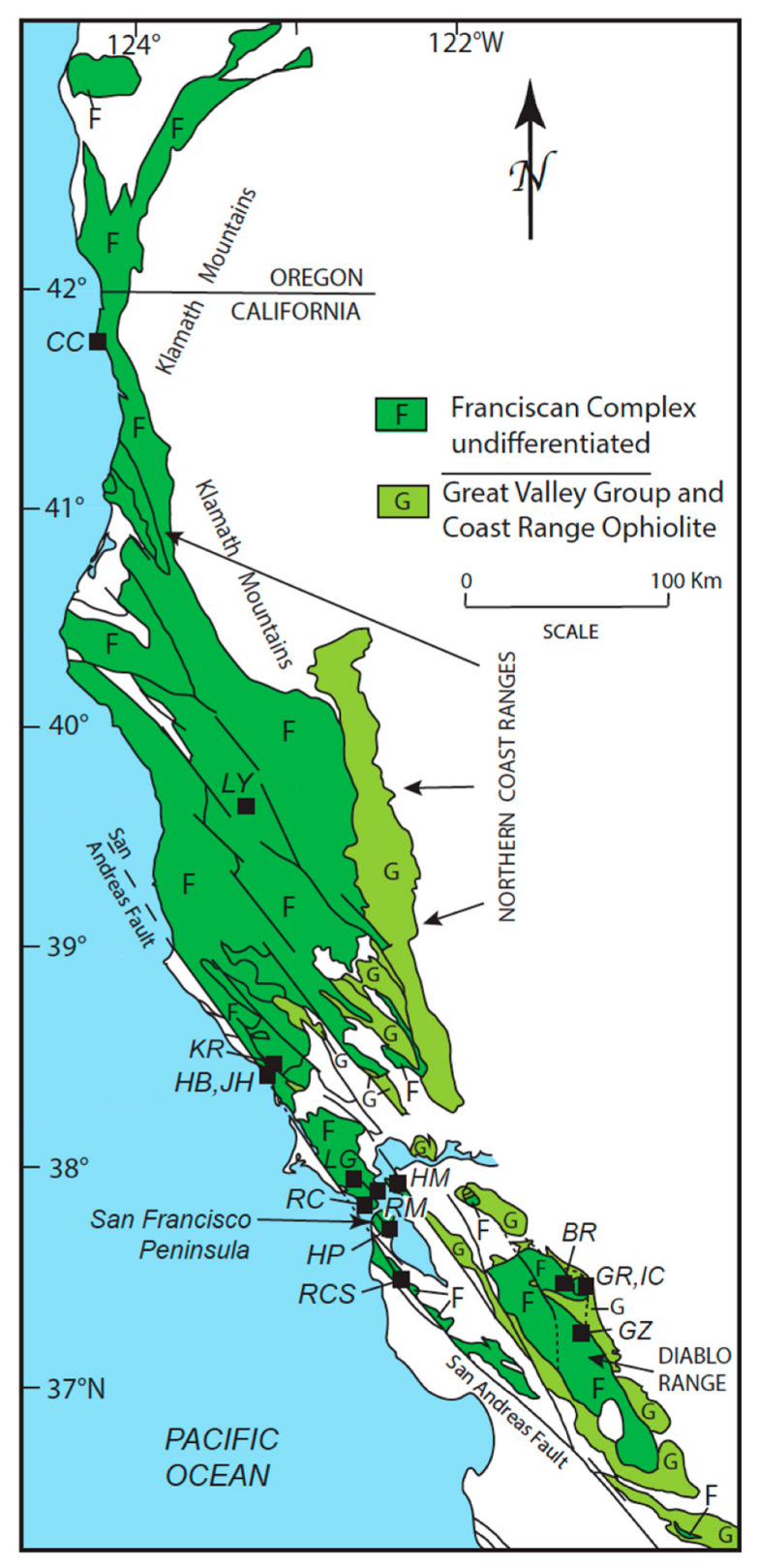
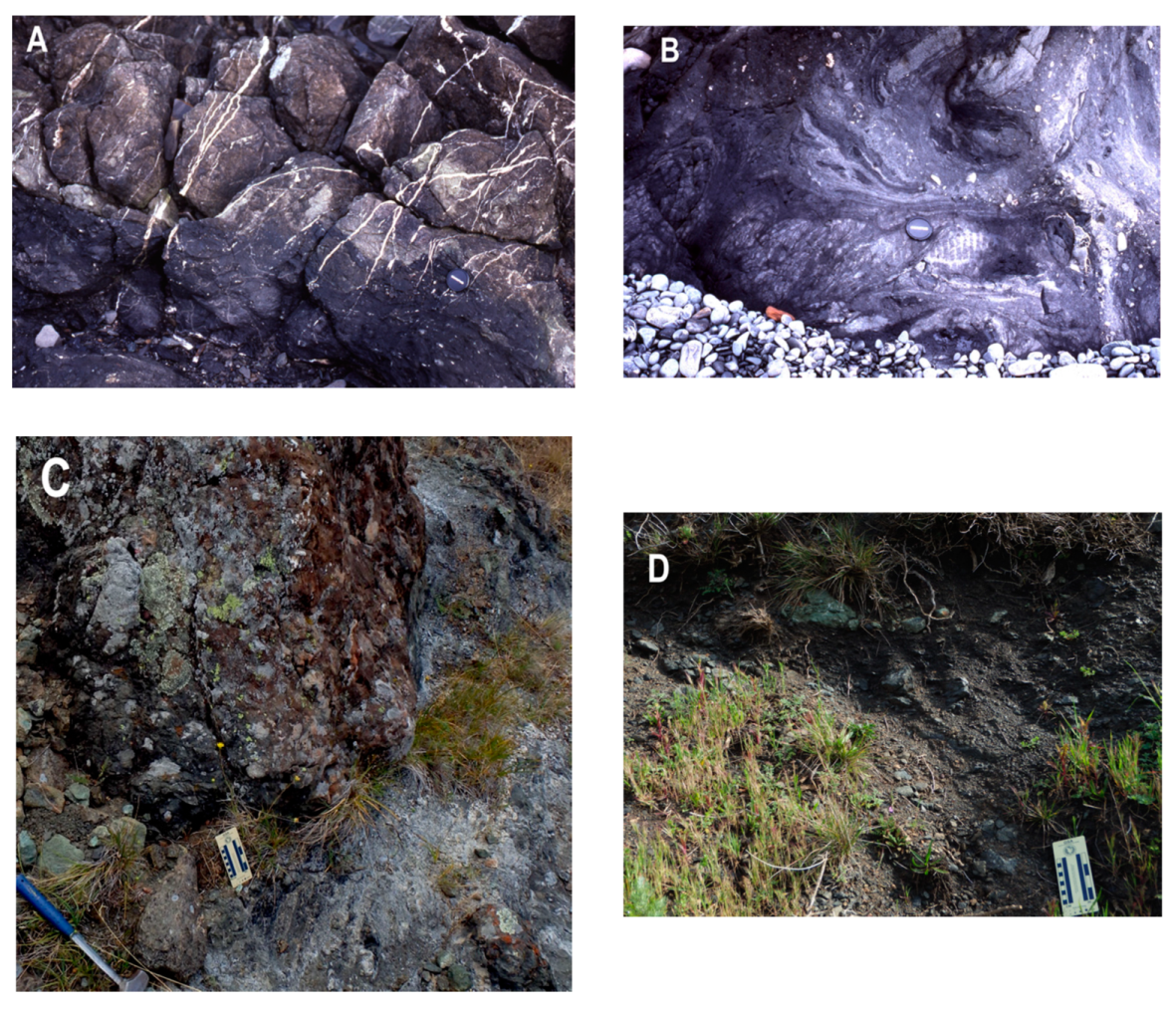
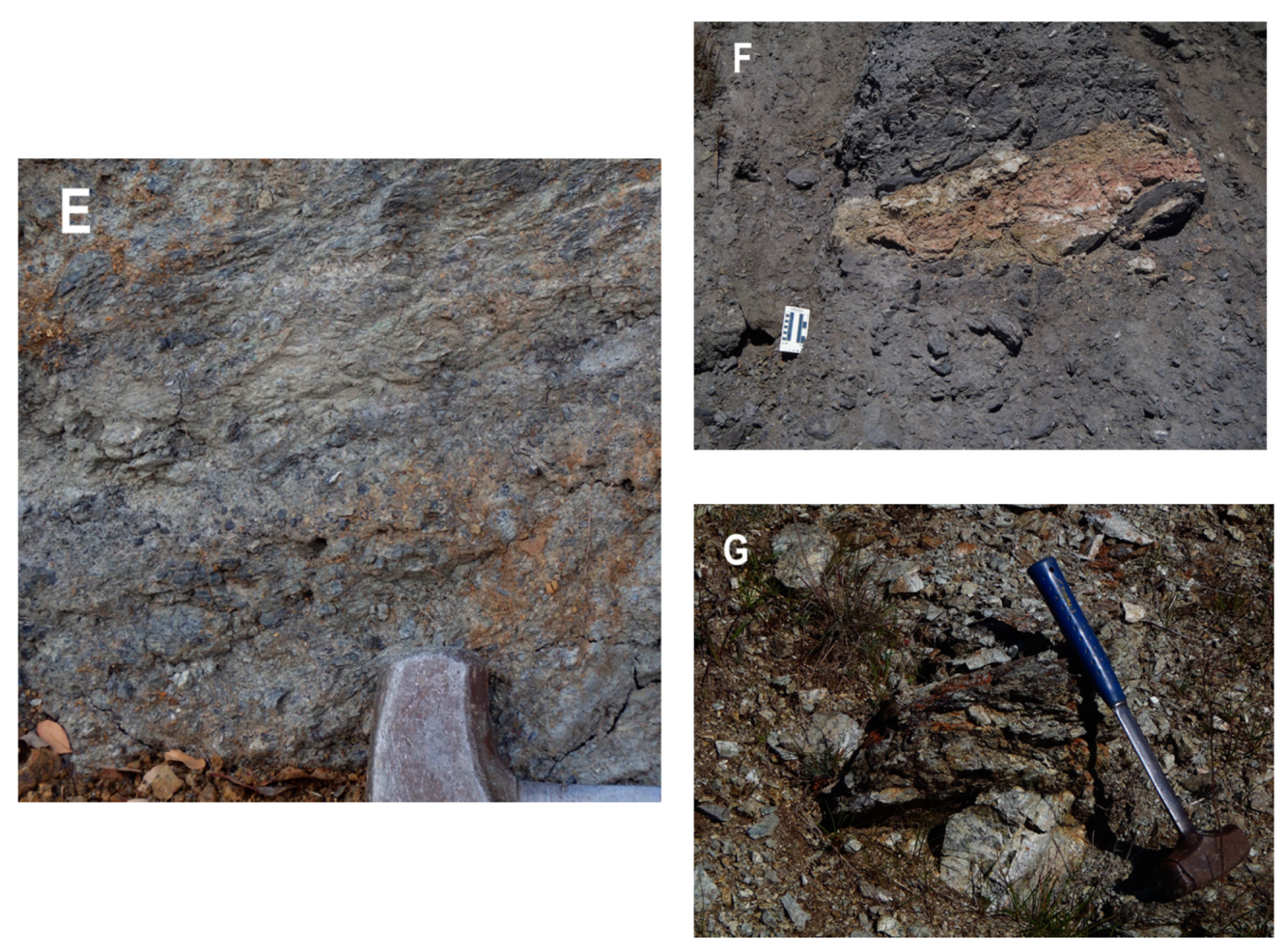
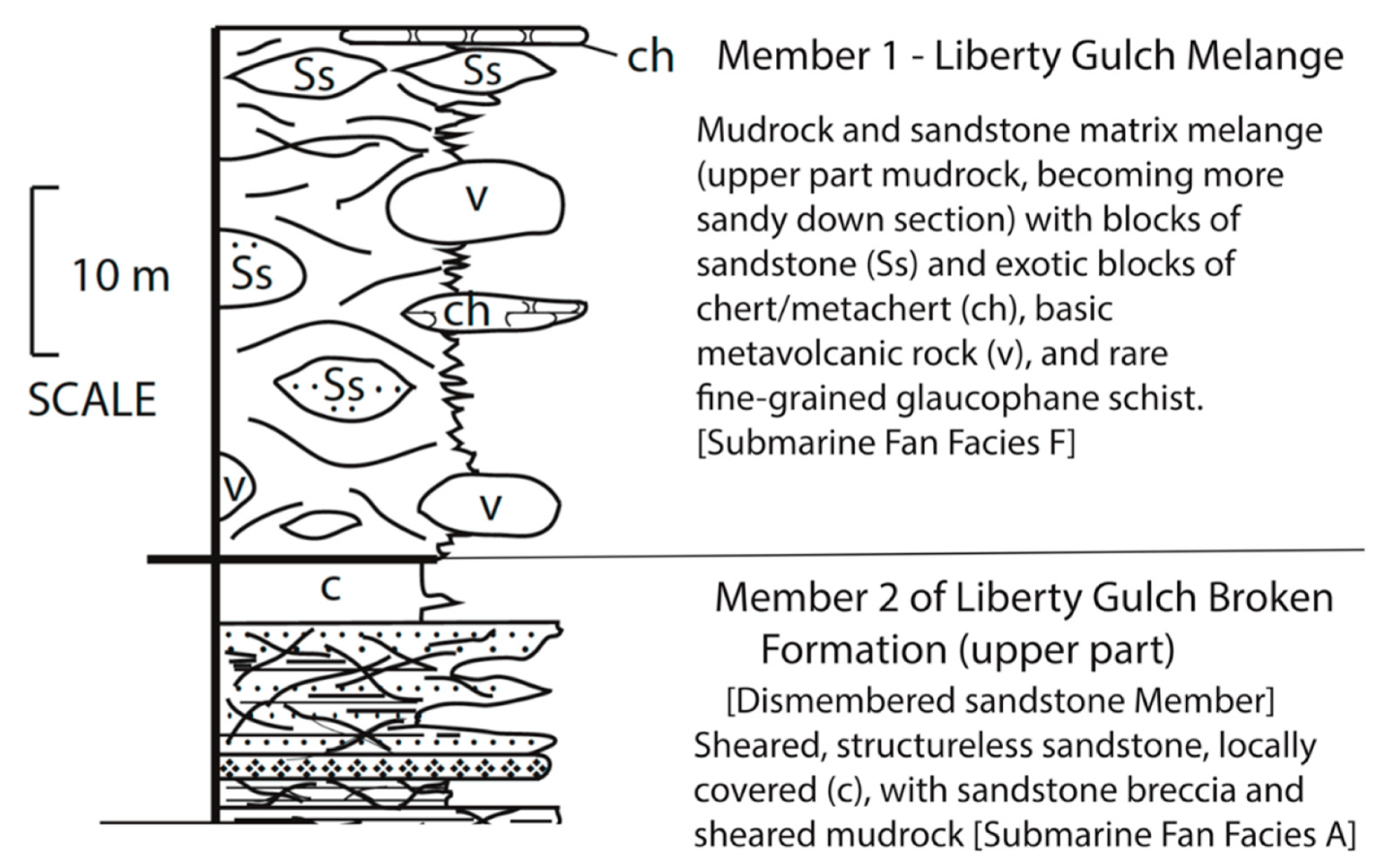
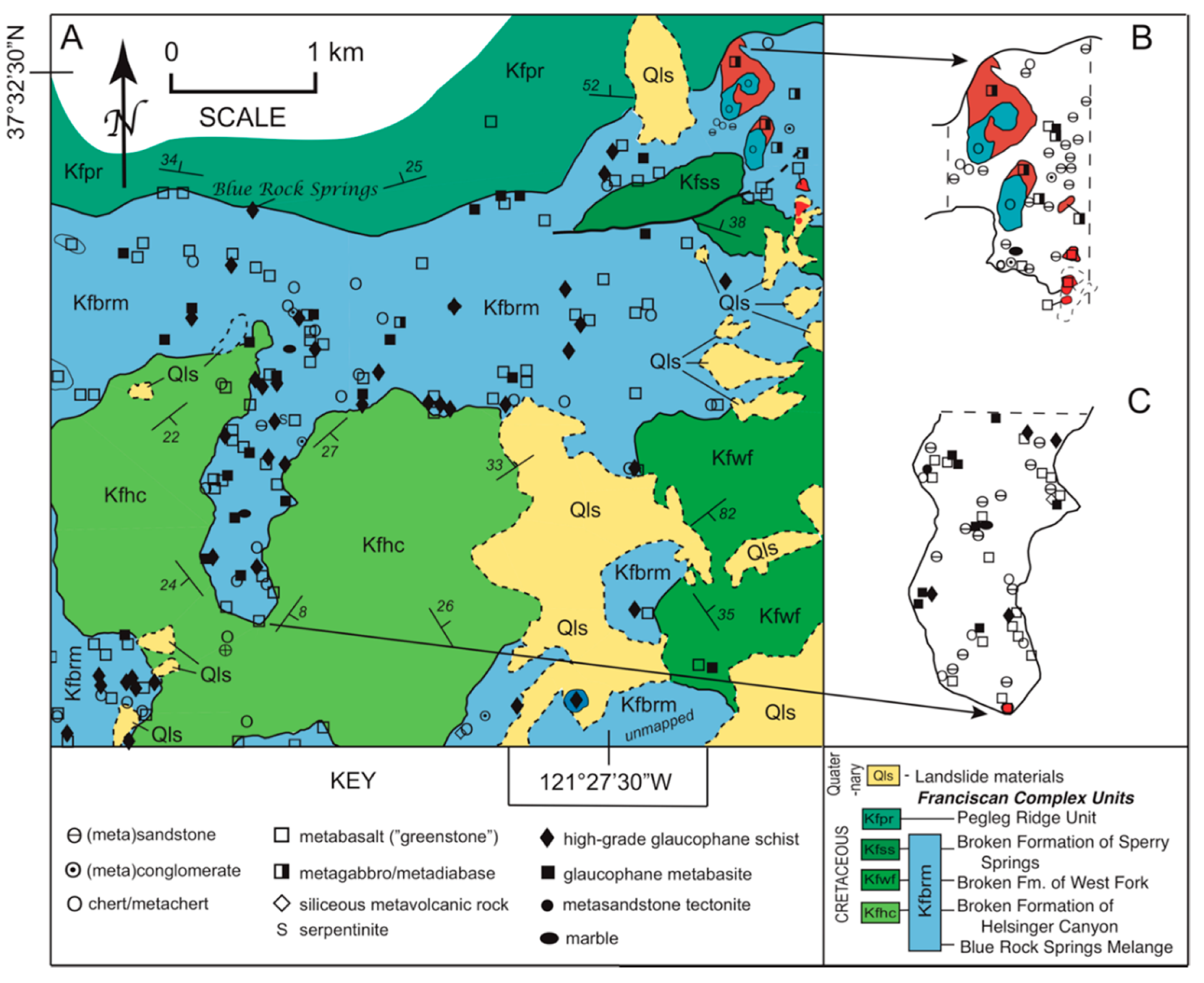
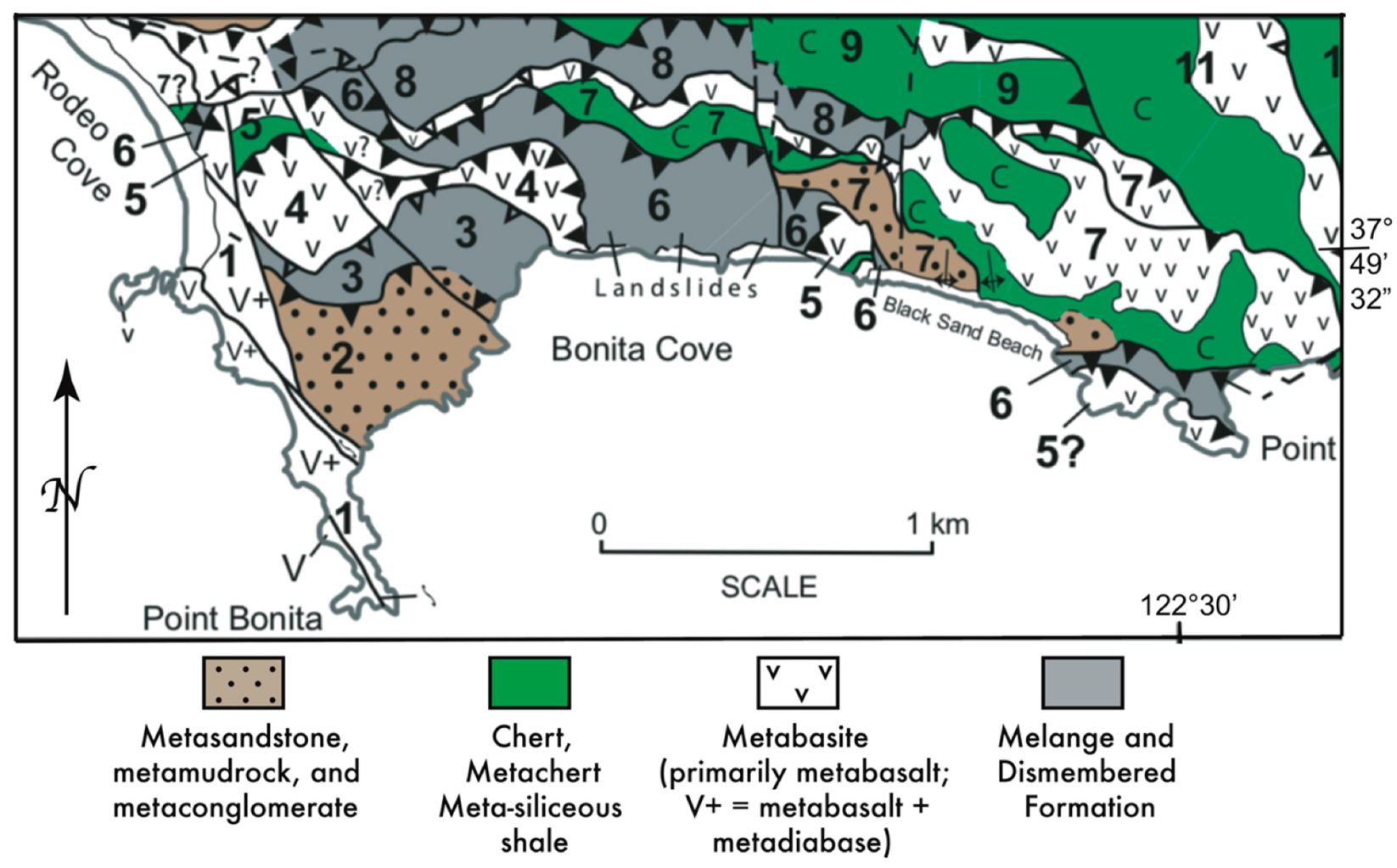
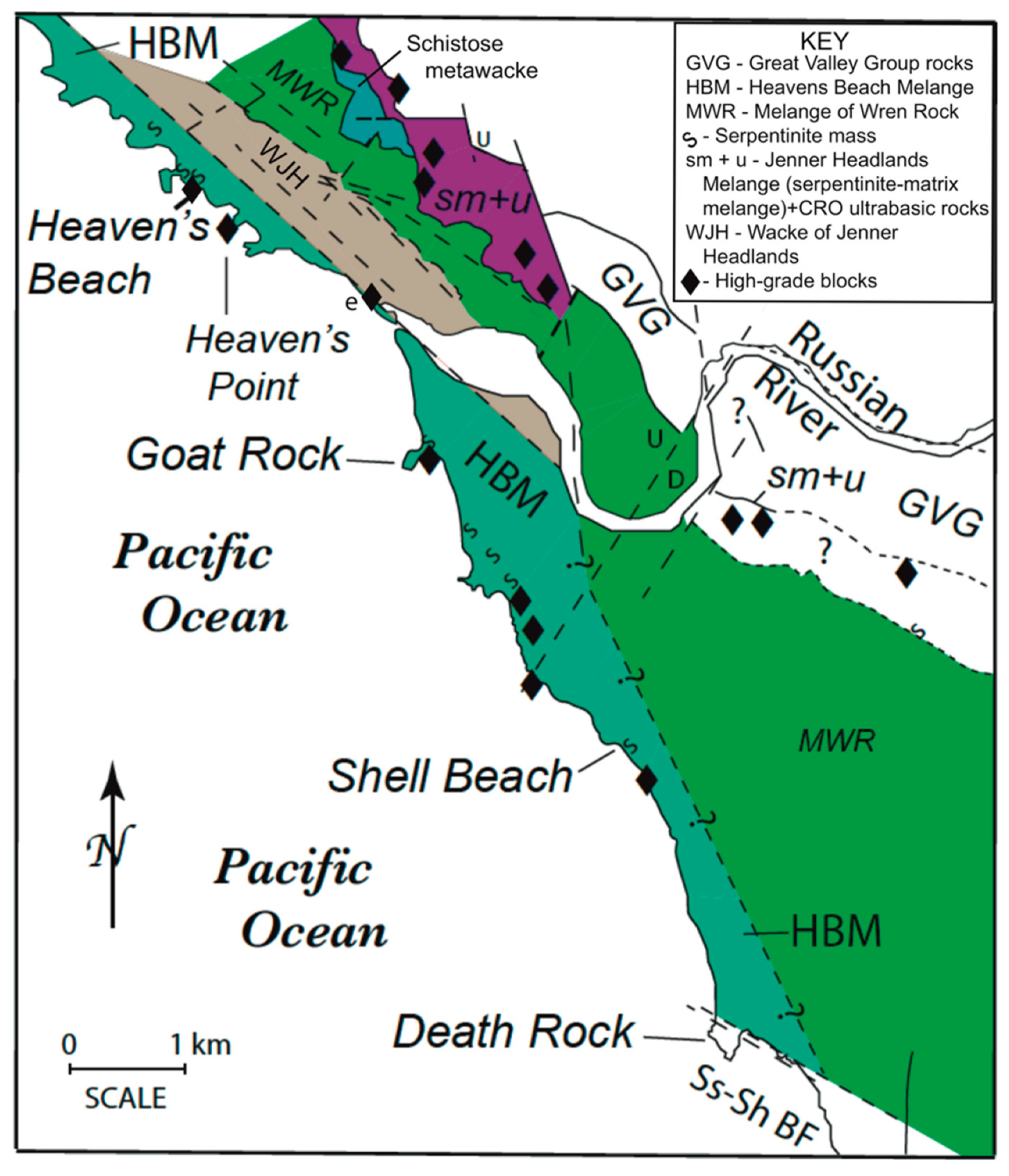
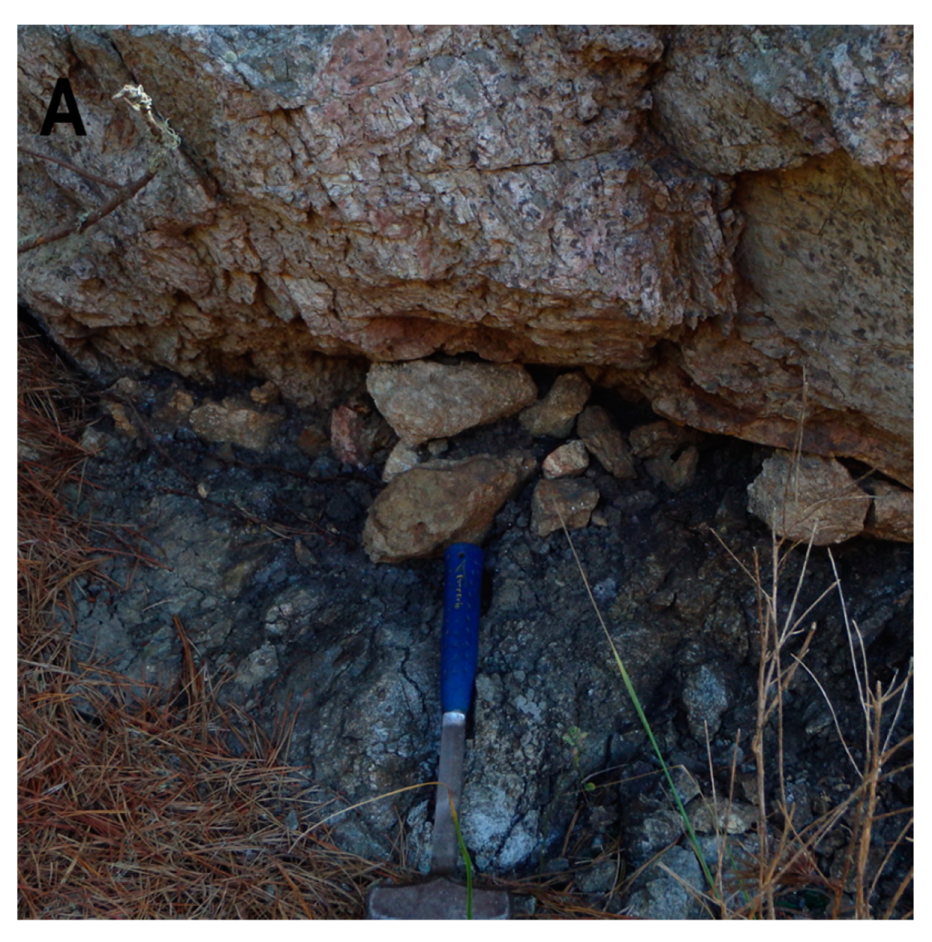
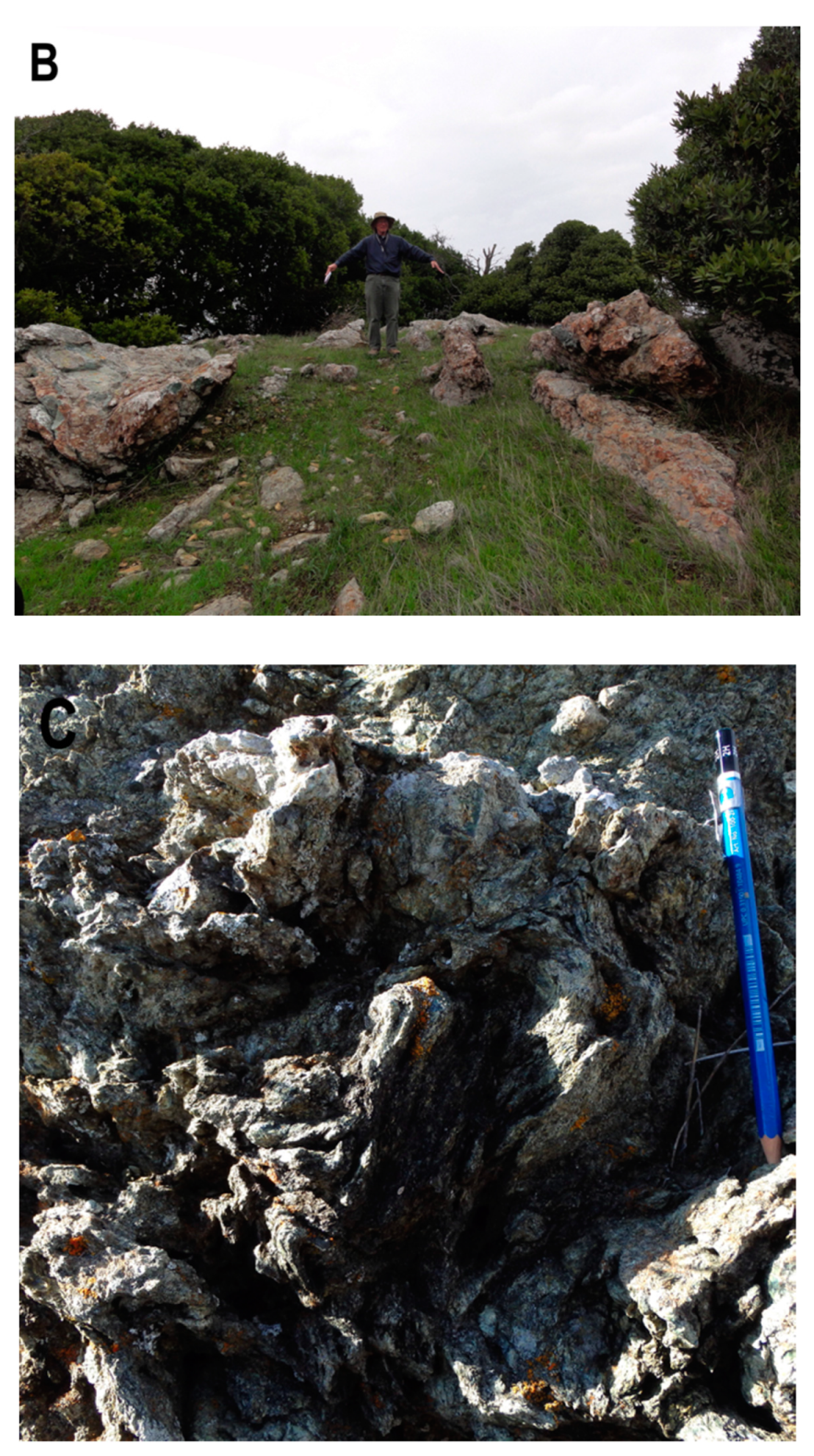
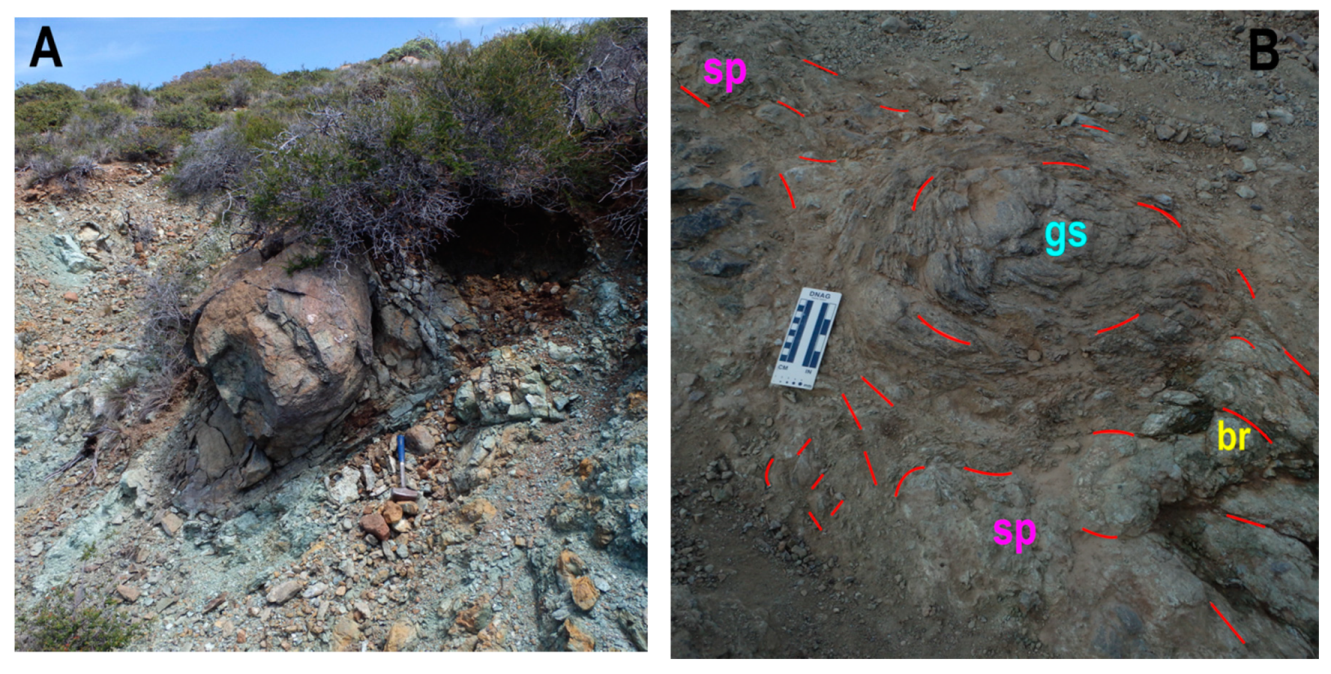
| Mélange --> Criteria a | Crescent City Olistostrome | Laytonville | King Ridge Road | Liberty Gulch | Hillside | Blue Rock Springs | Garzas | Ingram Canyon | Gerber Ranch | Rodeo Cove | Jenner Headlands | Hunters Point | Ring Mountain | Redwood City | Heaven’s Beach |
|---|---|---|---|---|---|---|---|---|---|---|---|---|---|---|---|
| Author Proposed Formation Mechanism b | S | S | S | S | S | S | T | T | T | T | T | T | S, T | D | P (S,T) |
| Sedimentary Mélanges | |||||||||||||||
| Irregular to tabular in map view | √ | √ | √ | √ | √ | √ | √ | √ | √ | √ | √ | √ | √ | √ | √ |
| Lenticular to tabular shape in section | √ | √ | √ | √ | √ | √ | √ | √ | √ | √ | √ | √ | √ | √ | √ |
| Depositional to gradational contacts c | √ | √ | Possibly | √ | √ | ||||||||||
| Irregular to sub-parallel stratigraphic boundaries | √ | √ | √ | √ | √ | ||||||||||
| Interbedded with stratigraphic layers | √ | √ | √ | √ | √ | ||||||||||
| Highly disordered isotropic fabric | √, in some | √ | √, In part | Locally in enclaves | Only in blocks | ||||||||||
| Matrix = mudrock (m), Sandstone (s), metabasites (b), Serpentinite (u) | √ (m) | √ (m,s) | √ (s) | √ (m) | √ (m,s) | √ (m) | √ (m±s) | √ (m) | √ (m,u) | √ (b,m,s) | √ (u) | √ (m,u) | √ (u) | √ (u) | √ (m,s) |
| Weak scaly cleavage at base | √ | √ | |||||||||||||
| Clast composition diverse | √ | √ | √ | √ | Not very | √ | √ | √ | √ | Not very | √ | Not very | √ | √ | |
| Native and exotic blocks | √ | √ | √ | √ | √ | √ | √ | √ | √ | √ | √ | √ | √ | √ | √ |
| Block size <1m–>1km | √ | √ | √ | √, small | √, small | √ | √ | √ | √ | √ | √ | √ | √ | √ | √ |
| Blocks rounded, irregular, angular, or tabular | √ | √ | √ | √ | √ | √ | √ | √ | √ | √ | √ | √ | √ | √ | √ |
| Well rounded clasts of various rock types | √ | √ | √ | √ | √ | √ | |||||||||
| Block margins sharp to diffuse with soft sediment deformation features | √ | Locally | |||||||||||||
| Fossils in matrix | |||||||||||||||
| Number of the 15 features matched | 13 (3 of 4 major) | 12 (2 of 4 major) | 9 (1 of 4 major) | 12 (3 of 4 major) | 11 (3 of 4 major) | 10 (2 of 4 major) | 8 (1 of 4 major) | 7 (0 of 4 major) | 7 (0 of 4 major) | 6 (0 of 4 major) | 7 (0 of 4 major ) | 6 (0 of 4 major) | 8 (1 of 4 major) | 6 (0 of 4 major) | 8 (1 of 4 major) |
| Tectonic Mélanges | |||||||||||||||
| Elongate to lenticular or irregular map shape | √ | √ | √ | √ | √ | √ | √ | √ | √ | √ | √ | √ | √ | √ | |
| Wedge to lenticular or tabular shape in section | √ | √ | √ | √ | √ | √ | √ | √ | √ | √ | √ | √ | √ | √ | √ |
| Sheared/deformed contacts | Minor Local | Locally | Minor Local | Locally | √ | √ | √ | √ | √ | √ | √ | √ | √ | √ | |
| Structurally ordered block-in-matrix (anisotropic) fabric | √, in part | √ | Locally | √ | √ | √ | √ | √ | √ | √ | √ | Locally | √ | ||
| Matrix composition mudrock, mudrock + sandstone, or serpentinite | √ | √ | √ | √ | √ | √ | √ | √ | √ | √ | √ | √ | √ | √ | √ |
| Block compositions variable | √ | √ | √ | √ | √ | √ | √ | √ | √ | √ | √ | √ | √ | Slightly | √ |
| Native and exotic blocks | √ | √ | √ | √ | √ | √ | √ | √ | √ | √ | √ | √ | √ | √ | √ |
| Facoidal, sigmoidal, tabular, to lenticular blocks | √ | Some | Common | √ | √ | √ | √ | √ | √ | √ | √ | Locally | √ | ||
| Blocks = <1m–>1km | √ | √ | √ | √ | √ | √ | √ | √ | √ | √ | √ | √ | √ | √ | √ |
| Microfabric scaly ± microbreccia and pseudotachylite | √ | √ | In black rock zone at top of mélange | √ | √ | √ | √ | √ | √ | √ | √ | Locally | In part | ||
| Anastamosing shears and microshears | √ | √ | Locally | Locally | √ | √ | √ | √ | √ | √ | √ | √ | Locally | √ | |
| S-C, P-R fabrics | √ | √ | √ | √ | √ | ||||||||||
| Boudinage common | √ | √ | √ | √ | √ | √ | √ | √ | |||||||
| Folds common | Slump folds | In some blocks and matrix | In some blocks | √ | Overprint/ Cenozoic folds | In blocks | In some blocks and matrix | In veins | In blocks | ||||||
| Striations common | √ | √ | √ | √ | √ | ||||||||||
| Veins common | Mudrock | √ | √ | √ | √ | √ | √ | ||||||||
| Number of the 16 features matched | 13 (1 of 3 major) | 11 (1 of 3 major) | 8 (1 of 3 major) | 8 (0 of 3 major) | 13 (2 of 3 major) | 11 (2 of 3 major) | 12 (3 of 3 major) | 15 (3 of 3 major) | 15 (2 of 3 major) | 14 (3 of 3 major) | 14 (2 of 3 major) | 11 (2 of 3 major) | 14 (3 of 3 major) | 12 (3 of 3 major) | 13 (2 of 3 major) |
| Diapiric Mélanges | |||||||||||||||
| Internal structural zoning of body from anisotropic to isotropic | |||||||||||||||
| Circular to elliptical on maps; commonly zoned | √ | ||||||||||||||
| Section conical to cylindrical | |||||||||||||||
| High angle discordant to conformable contacts | √ | √ | √ | √ | √ | √ | √ | √ | √ | √ | √ | √ | √ | √ | √ |
| Deformation zoned with core noncylindrical folds and rim scaly fabric | |||||||||||||||
| Native and exotic blocks | √ | √ | √ | √ | √ | √ | √ | √ | √ | √ | √ | √ | √ | √ | √ |
| Blocks irregular in core; phacoidal blocks in rim | |||||||||||||||
| Blocks = <1m–15+ m; smaller in rim zone | |||||||||||||||
| Block composition variable, but sandstone common and serpentinite possible | √ | √ | √ | √ | √ | √ | √ | √ | √ | √ | No-Mainly Serpentin-ite | √ | |||
| Clasts randomly oriented in core zone | |||||||||||||||
| Marginal zone has aligned elongated clasts | |||||||||||||||
| S-C fabric in marginal zone | |||||||||||||||
| Sub-vertical microfabric in Matrix relative to nearby sedimentary layers | |||||||||||||||
| Number of the 13 features matched | 3 (0 of 4 major) | 3 (0 of 4 major) | 2 (0 of 4 major) | 3 (0 of 4 major) | 3 (0 of 4 major) | 3 (0 of 4 major) | 3 (0 of 4 major) | 3 (0 of 4 major) | 3 (0 of 4 major) | 3 (0 of 4 major) | 2 (0 of 4 major) | 3 (0 of 4 major) | 3 (1 of 4 major) | 2 (0 of 4 major) | 3 (0 of 4 major) |
| Sources | [6,34,35,36,37,38] | [28,39,40] | [41] | [32,42] | [20,42,43,44] | [2,45] | [2,11,42, 46,47,48,49] | [2,45,46,47,48] | [2,45,48] | [23,50,51] | [7,52,53] | [54] | [3,55,56] | [57] | [3,32] |
| Mélange a ---> | King Ridge Road c | Laytonville | Hillside | Heaven’s Beach | Gerber Ranch | Garzas | Liberty Gulch | Crescent City | Blue Rock Springs | Rodeo Cove | Hunters Point | Ingram Canyon | Jenner Headlands | Ring Mountain | Redwood City |
|---|---|---|---|---|---|---|---|---|---|---|---|---|---|---|---|
| Author Proposed Origin b | S | S | S | P (S,T) | T | T | S | S | S | T | T | T | T | S, T | D; (T-herein) |
| Matrix type c | Ss | MS | MS | MS | MS | MS; M | M; MS | M | M | M | M + Sp | M + Sp | Sp | Sp | Sp |
| Ocean Plate Stratigraphy Rocks (see rock types below) | |||||||||||||||
| Serpentinized peridotite, pyroxenite | √ | √ | √ | √ | √ | √ | √ | ||||||||
| Serpentinite | √ | √ | √ | √ | √ | √ | √ | √ | |||||||
| Basalt and metabasalt | √ | √ | √ | √ | √ | √ | √ | √ | √ | √ | √ | √ | √ | √? | √ |
| Chert and metachert | √ | √ | √ | √ | √ | √ | √ | √ | √ | √ | √ | √ | √ | √? | √ |
| Sandstone and metasandstone | √? | √ | √ | √ | √ | √ | √ | √ | √ | √ | √ | √ | √ | √? | √ |
| Conglomerate and metaconglomerate | √ | √ | √ | √ | √ | √ | √ | ||||||||
| Other Exotic Rocks | |||||||||||||||
| Glaucophane schist | √ | √ | √ | √ | √ | √ | √ | √ | √ | √ | √ | ||||
| Eclogite | √ | √ | √ | √ | √ | ||||||||||
| Hornblende schist and gneiss | √ | √ | √ | √ | √ | √ | √ | √ | |||||||
| Volcanic rocks other than basalt | √ | √ | √ | √ | √ | ||||||||||
| Granitoid rocks | √ | √ | √ | √ | |||||||||||
| Other | √ | √ | √ | √ | √ | √ | √ | √ | √ | √ | √ | √ | |||
| a—Sources | [40] | [28,39,40] | [20,42,43,44] | [3,32] | [2,45,48] | [2,11,43, 46,47,48,49] | [32,42] | [6,34,36,37,38] | [2,45] | [23,50,51] | [54] | [2,45,48] | [7,52,53] | [3,55,56] | [57] |
© 2019 by the author. Licensee MDPI, Basel, Switzerland. This article is an open access article distributed under the terms and conditions of the Creative Commons Attribution (CC BY) license (http://creativecommons.org/licenses/by/4.0/).
Share and Cite
Raymond, L.A. Origin of Mélanges of the Franciscan Complex, Diablo Range and Northern California: An Analysis and Review. Geosciences 2019, 9, 338. https://doi.org/10.3390/geosciences9080338
Raymond LA. Origin of Mélanges of the Franciscan Complex, Diablo Range and Northern California: An Analysis and Review. Geosciences. 2019; 9(8):338. https://doi.org/10.3390/geosciences9080338
Chicago/Turabian StyleRaymond, Loren A. 2019. "Origin of Mélanges of the Franciscan Complex, Diablo Range and Northern California: An Analysis and Review" Geosciences 9, no. 8: 338. https://doi.org/10.3390/geosciences9080338
APA StyleRaymond, L. A. (2019). Origin of Mélanges of the Franciscan Complex, Diablo Range and Northern California: An Analysis and Review. Geosciences, 9(8), 338. https://doi.org/10.3390/geosciences9080338




